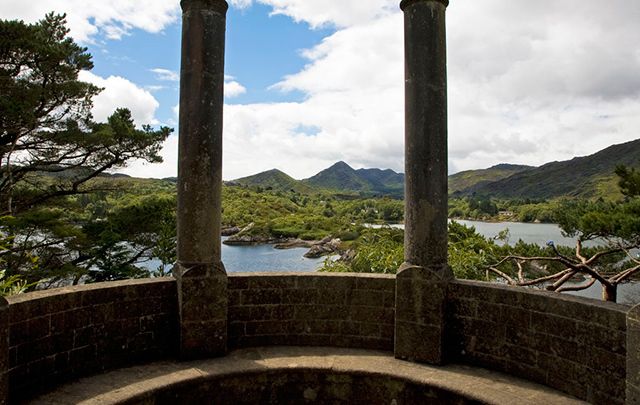As Ireland's largest county, Co. Cork is very proud of all that it has to offer the world, with Corkonians staunchly arguing that their own capital, Cork City, is the true capital city of Ireland.
Also known as the Rebel County, Cork has a rich history, with one of Ireland's most famous castles in Blarney as well as one of the world's most famous stones.
With the second largest natural harbor in the world (second only to Sydney) it's not just man-made history that makes Cork a perfect travel destination, however, and with views such as the Beara peninsula, you'll never want to leave.
With so much to see, here are our top five attractions to get you started:
1. Fota Wildlife Park
The animals roaming across Fota. 
Visited by almost 440,000 people annually, Fota Wildlife Park consists of 100 acres of parkland where animals such as the kangaroo, emu, European bison, zebra, giraffe, and ostrich can roam freely.
First opened in 1983 on Fota Island, six miles east of Cork City, the Park is located on part of what was the estate of the Smith-Barry family for nearly 800 years and is the second largest visitor attraction in Ireland outside of Leinster.
Kids watching the animals up close and personal in Fota Wildlife Park. 
The ideal family attraction, the park can be explored on foot, taking in the animals as you go along, or by the safari train. From the roar of the lions to the acrobatics of the monkeys, Fota will wow young animal lovers and rightfully earned its place in the Top 25 Zoos/Animal Parks in Europe in the 2015 Tripadvisor Travellers Choice Awards.
More info: http://www.fotawildlife.ie/
2. Blarney Castle
Always topping the lists of top things to do in Ireland, Blarney Castle is home to the famous Blarney Stone, said to give the gift of the gab to anybody who kisses it. The stone was built into a tower of the Blarney Castle in 1446 but its exact origins are unknown, some linking it to the goddess Cliodhna and Cormac Laidir MacCarthy, while others believe a witch saved from drowning revealed its powers to the McCarthys, the lords of Blarney.
Apart from the stone, kissed by hundreds every year, Blarney is always worth a visit for the history of the castle itself, as well as their immaculate gardens. A medieval castle built over 600 years ago outside of Blarney town by one of Ireland’s greatest chieftains, Cormac McCarthy, Blarney is extremely well-preserved.
Visitors can also explore the beautiful grounds full of their own history—the magical gardens, the mystical Rock Close, the Badger’s Cave, a dungeon, the spell-binding Witches Stone and kitchen, and the Wishing Steps, as well as small streams, brooks, and a lake.
More info: http://www.blarneycastle.ie/
3. Garnish Island, the Beara Peninsula
Garnish Island, located on the Beara Peninsula, is known all over the world for its exquisite Italian gardens. While the Beara Peninsula itself is a perfect tourist spot, with the 92-mile “Ring of Beara” car trail bringing you along some of the most tranquil spots in Ireland, Garnish Island with its beautiful walks and specimen plants (some of which are rare to the Irish climate) is a stunning getaway in the sheltered harbour of Glengarriff in Bantry Bay. With thanks to the harbor and the woodlands planted a hundred years ago, the island enjoys its very own micro-climate allowing these exotic species to flourish.
The amazing island garden, which includes features such as the Martello Tower (an original feature of the Island dating from 1805), a Grecian Temple on the western side and an Italian temple, can be visited by ferry from Glengarriff Pier. The ferry also stops off at seal island to see an incredible tame seal colony.
A seal colony on the ferry trip to Garnish Island, Co. Cork. 
The vision of Annan Bryce and Harold Peto, an architect, and a garden designer, the island was given to the Irish people in 1953 and placed into the care of the Commissioners of Public Works.
More info: http://www.garnishisland.com/
4. Spike Island
An aerial shot of Spike Island. 
Once the largest convict depot in the world, Spike Island has hosted both a 6th-century monastery and a 24-acre fortress over the past 1300 years, a history rich in both saints and sinners.
By taking the scenic ferry route from Cobh to the Island, visitors can now explore the 200-year-old Fort Mitchell, the star-shaped fortress where over 2,300 visitors were once held.
Read more: Spike Island – Ireland’s Alcatraz island prison (PHOTOS)
The entrance to Fort Mitchel on Spike Island. 
Formerly known as “Ireland’s Hell”, tours of the island and its folklore and social and military history are offered during the day for families. For those wishing to discover more about the darker qualities of this island prison, however, nighttime tours will spook visitors with horrifying tales of how convicts were treated when the prison was at its largest in the 1850s, and of the foul conditions endured during especially during the famine years.
More info: http://www.spikeislandcork.ie/
5. The Shandon Bells
Located in close proximity to the equally popular Cork Butter Museum, the Shandon Bells and tower can be found in St. Anne’s Church in the Shandon area of Cork City. The eight world-famous, 18th-century bells can be rung by visitors on the first floor, where hundreds of people have made them chime since they first rang on December 7, 1752.
Climbing the 132 steps up the tower to the balcony standing 131 ft above the ground offers an incredible 360-degree view of Cork City from one of the country’s most beautiful churches, built in 1722. A striking landmark in the city, the tower is also home to the clock named the “Four-Faced Liar”, so named because locals noticed that the four clock faces on the sides of the tower could never seem to agree on an exact time.
More info: http://www.shandonbells.ie/




Comments